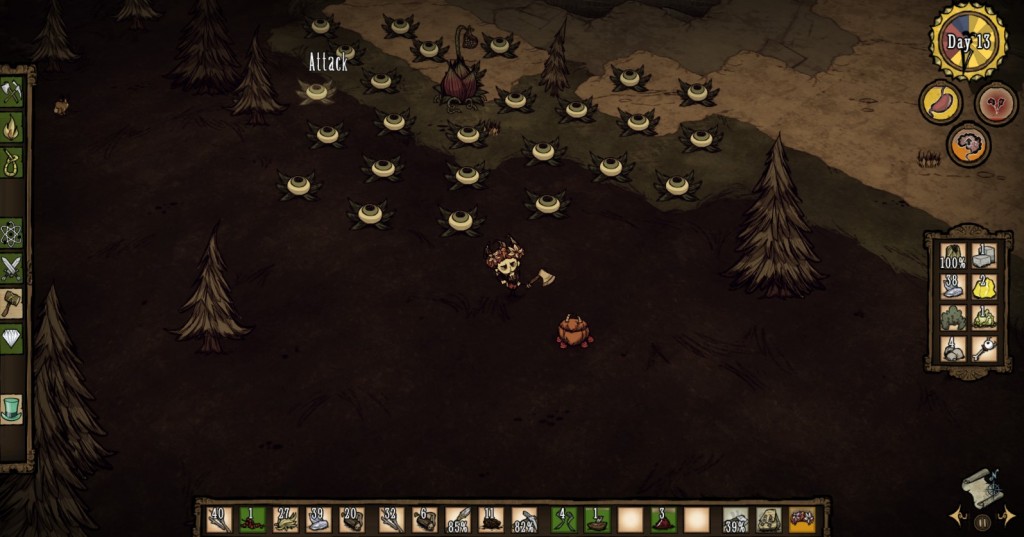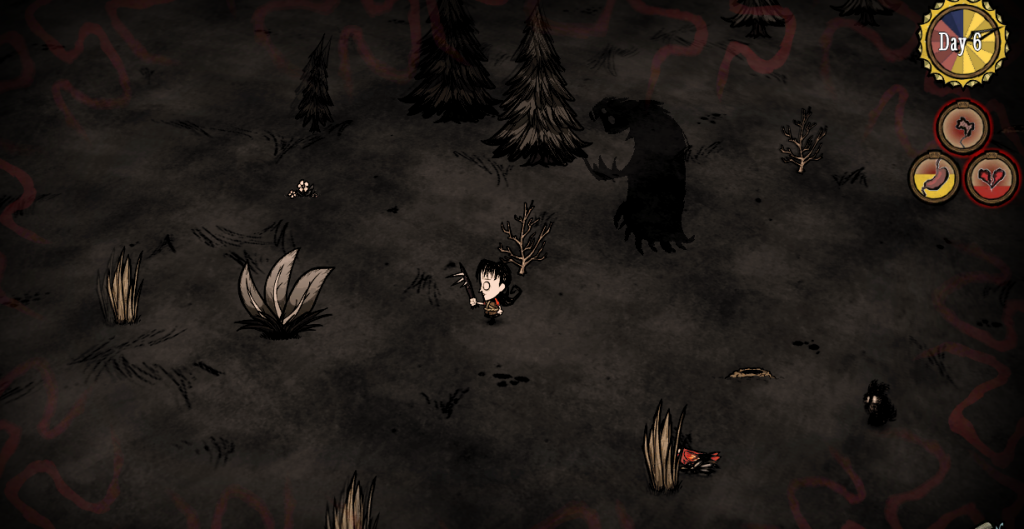When I began my journey with Don’t Starve, I swiftly learned a few lessons. First lesson: Some survival tactics work as they do in the real world, such as using manure to feed a fire. Second lesson: Some survival tactics do not work as they do in the real world, such as using fire to clear a beehive. Third lesson: oh god, don’t mess with the beehives! In fact, the most valuable lesson one can learn from the unforgiving wilderness of Don’t Starve is “don’t touch that”. But you have to touch that, because you have been abandoned to your own devices on a hellish, uninhabited wilderness, and must find a way to survive.
The best way to describe Don’t Starve is a roguelike survival game with a charming and fitting early 20th century designed aesthetic. You will start the game in a random map with nothing but the clothes on your back and your wits to survive. You will quickly begin to gather resources, trying to find the best use for the things you get. The game is not stingy. Within minutes you will most likely find food, and the components you will need to craft the tools needed for your basic survival needs. It soon becomes clear that this generosity is not because the game is being magnanimous, but rather, because these are the bare minimum components you need to do something as basic as survive through the first night. As you advance through the game, explore, and acquire more components and craft more items, you will learn that things have uses that are not always evident. In fact everything is useful in some way, which makes managing your inventory and prioritizing what you take with you vital to your long term success. Exploration and experimentation then, are key in Don’t Starve.
It is somewhat paradoxical that Don’t Starve seems to punish said exploration and experimentation far more often than it seems to reward it. Just about everything in the game is hostile and potentially lethal. Things that seem curious or unusual are almost guaranteed to attack you or harm you when you go investigate. Health is slow to recover, and the items that provide any substantial amount of healing must be either crafted or found by killing monsters. Enemies gang up on you, and often attack when you are vulnerable (such as at night where you can’t let go of your torch or abandon your campfire), and it is sometimes hard to tell which creatures are hostile, since many creatures will leave you alone as long as you do the same.
Aside from keeping your character healthy, and to keep them fed, there is a third stat that you need to care for: Sanity. As you try to survive the horrible conditions, left alone and isolated, your character will slowly lose sanity, especially at night or by using specific items or coming in contact with some of the stranger aspects of the game. Sanity has some real effects on gameplay. Characters will start seeing things in the night, and hearing strange sounds. They will see shadows during the day, and hear whispers. As their sanity continues to deteriorate, wildlife will become more hostile, and at some point, even shadows will attack you. While Don’t Starve is not the first game to use sanity as a mechanic for game play, it does do some interesting things with it. Some areas are not available while sane, as well as some items. This will make it worth your while to take calculated risks and allow your sanity to drop at some points of the game.
The game is challenging, and in true rougelike fashion, when you die you lose all progress. You will start the game again with a new randomly generated map, and will have to start with nothing once again. For those who persevere past those initials playthroughs, however, there are rewards to be had in discovering all the game has to offer. The game gets easier as you will learn more about how to defeat monsters, how to catch food more efficiently, and the many uses of items, some which are not evident. There are many interesting things hidden in the world of Don’t Starve, things that pop out only at specific times, whole other layers of game to find, and even an entirely separate adventure mode hidden deep within the game, and part of the enjoyment of the game is seeing what you can find as you survive and thrive.
To prevent the game from getting repetitive, Don’t Starve allows you to customize the game to change your experience. You can adjust how often specific items, monsters, or animals spawn, what season it is, or even make the game take place exclusively in darkness if you feel particularly masochistic. At the end of each playthrough you are rewarded with experience proportional to the longevity of your characters, which allows you to unlock new characters to play as. These characters have different advantages and drawbacks. For example, a character starts the game with a lighter, but she will set fires when her sanity drops. These subtle differences can affect how the game is played to a surprising degree, and do a good job of ensuring the game doesn’t get stale.
Don’t Starve is certainly not for everyone. It is a game that pulls no punches, and expects that the only thing you will carry from one playthrough to the next are the lessons that you have learned. It unfortunately does rely on some trial and error gameplay, especially in the early playthroughs when you have little experience with the world and what is within it. It can be frustrating to be deep within a game, have a base, sustainable food sources, and a good plan for long term survival, only to explore somewhere new and be killed by something you hadn’t encountered before. As many times as I swore I was done with Don’t Starve, though, I always found myself coming back to try again, and that is probably the best recommendation one can give this type of game. If you are a fan of randomly generated roguelikes or survival games, it is definitely worth the $14.99 price tag.









